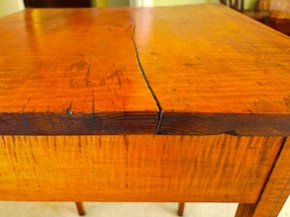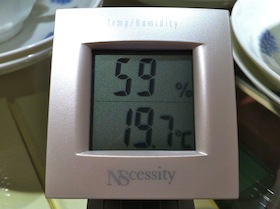


We have mentioned this subject before on this blog; however as Autumn is now very much upon us - and therefore so is central heating – and knowing the terrible damage which can occur through neglect of this issue, it seems right to revisit it, and impress again on all you owners of antique furniture, the importance of humidity.
.jpg) This lovely little antique satinwood table used to live in a period property; and did so, very happily, for many years. Last summer the owner moved to a modern house, and by April of this year this is what had happened.
This lovely little antique satinwood table used to live in a period property; and did so, very happily, for many years. Last summer the owner moved to a modern house, and by April of this year this is what had happened.
Basically, a combination of better building insulation and central heating conspired to parch the wood of moisture, and caused the warping and cracking you can see in these photographs.
Antique wood has a higher moisture content than modern furniture wood, because the techniques used to dry the wood out prior to manufacture are far more effective now than they used to be. This means antique wood is very susceptible to reductions in humidity levels.

Period properties generally have quite high internal humidity levels because they have much poorer insulation than modern houses and therefore more moist external air circulates inside. Because modern insulation is more effective, the drying effect of central heating is also more pronounced in modern houses. This means that when this table was moved, the humidity level of the surrounding air changed from around 60% to 40%; drying out the wood and causing the damage.
The very best thing you can do to prevent this from happening to your antique furniture is to buy a humidity meter. This means you can monitor the humidity in a room and take action if necessary.
 A level of between 50% - 60% humidity is ideal. If you need to increase the level in a room, you can use a humidifier; or alternatively, small bowls of water placed on or near radiators will do the trick. Just make sure you keep them topped up.
A level of between 50% - 60% humidity is ideal. If you need to increase the level in a room, you can use a humidifier; or alternatively, small bowls of water placed on or near radiators will do the trick. Just make sure you keep them topped up.